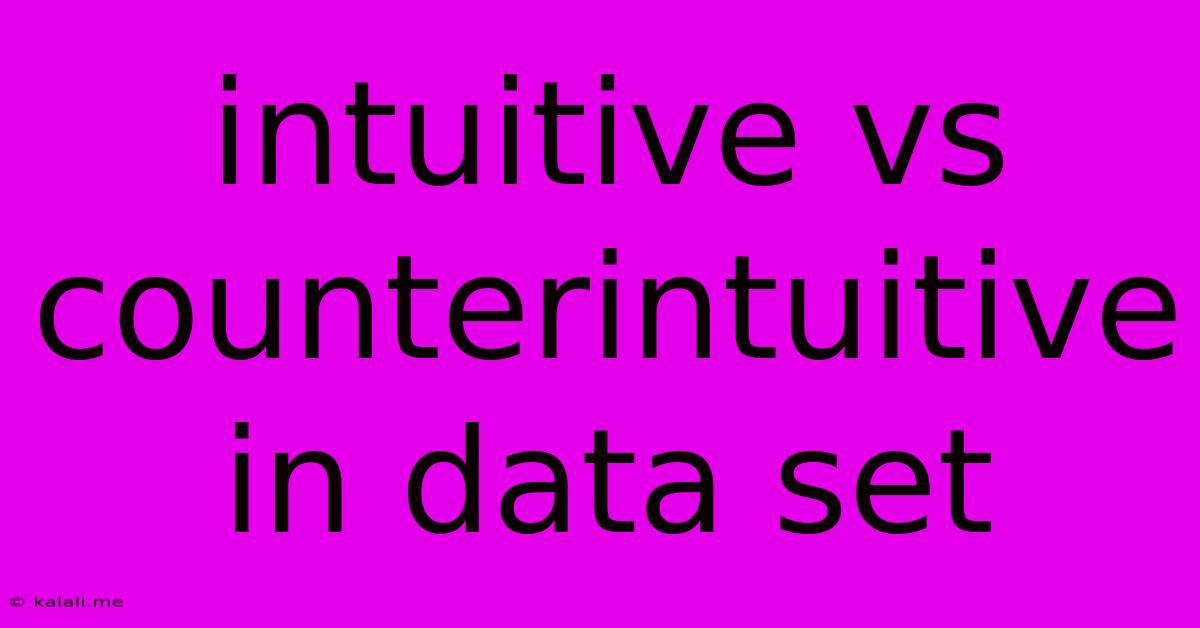Intuitive Vs Counterintuitive In Data Set
Kalali
Jun 07, 2025 · 3 min read

Table of Contents
Intuitive vs. Counterintuitive Insights in Data Sets: Uncovering Hidden Truths
Understanding data can feel like navigating a labyrinth. Sometimes, the path forward is clear – the insights are intuitive, aligning with our pre-existing beliefs and expectations. Other times, the data reveals a completely unexpected turn, leading to counterintuitive findings that challenge our assumptions. This article explores the differences between these two types of insights, their importance in data analysis, and how to approach each effectively.
What are Intuitive Insights?
Intuitive insights are those that readily align with our prior knowledge, experience, and common sense. They are often easily understood and readily accepted, requiring minimal explanation. For example, if you're analyzing sales data and discover that sales are higher during the holiday season, that's an intuitive finding. We already expect increased sales during periods of heightened consumer spending. These insights, while valuable, often represent the "low-hanging fruit" of data analysis and may not provide a competitive edge or reveal truly novel understandings.
- Characteristics of Intuitive Insights:
- Easily understandable
- Align with prior expectations
- Often obvious and predictable
- Require minimal explanation
- Valuable but may not be groundbreaking
What are Counterintuitive Insights?
Counterintuitive insights, on the other hand, challenge our assumptions and preconceived notions. They are unexpected, surprising, and often require further investigation to fully understand their implications. These are the findings that can truly disrupt the status quo and lead to significant advancements in understanding a phenomenon. For instance, discovering that a seemingly insignificant product feature correlates strongly with customer retention, despite initial assumptions to the contrary, would be a counterintuitive insight.
- Characteristics of Counterintuitive Insights:
- Unexpected and surprising
- Challenge pre-existing beliefs
- May require further investigation to explain
- Can lead to groundbreaking discoveries
- Potentially more valuable than intuitive findings
The Importance of Both Types of Insights
Both intuitive and counterintuitive insights play a crucial role in effective data analysis. Intuitive findings provide validation and confirmation of existing hypotheses, while counterintuitive findings force us to re-evaluate our assumptions and explore new possibilities. A balanced approach, embracing both types of insights, is essential for a comprehensive understanding of the data. Ignoring counterintuitive results because they are unexpected can lead to missed opportunities and flawed conclusions. Similarly, relying solely on intuitive findings can limit the depth and scope of your analysis.
How to Effectively Approach Intuitive and Counterintuitive Insights
- Validation: For intuitive insights, focus on validating them through rigorous statistical methods and cross-referencing with other data sources.
- Exploration: For counterintuitive insights, prioritize a thorough investigation. Explore potential confounding factors, test alternative hypotheses, and delve deeper into the underlying mechanisms driving the unexpected relationship. Visualization techniques can be invaluable here.
- Critical Thinking: Apply a critical and skeptical lens to both types of insights. Avoid confirmation bias and always seek evidence to support or refute your findings.
- Communication: Clearly articulate both intuitive and counterintuitive findings, emphasizing the significance and implications of each. Provide context and explanation, especially for the more surprising results.
Conclusion
Mastering data analysis means embracing both intuitive and counterintuitive insights. While intuitive findings confirm what we already know, counterintuitive findings open doors to new discoveries and deeper understanding. By combining rigorous analytical methods with a critical and open mindset, you can unlock the full potential of your data and derive actionable intelligence that drives informed decision-making. This balanced approach is key to navigating the complex landscape of data and extracting meaningful insights.
Latest Posts
Latest Posts
-
Remote To Power On Mac Mini
Jun 07, 2025
-
Reasons A Check Engine Light Would Come On
Jun 07, 2025
-
Can You Replace A 2025 Battery With A 2032 Battery
Jun 07, 2025
-
What Does Quran Say About Jesus
Jun 07, 2025
-
Vscode Terminal Send Sequence Delete All Left Cusror
Jun 07, 2025
Related Post
Thank you for visiting our website which covers about Intuitive Vs Counterintuitive In Data Set . We hope the information provided has been useful to you. Feel free to contact us if you have any questions or need further assistance. See you next time and don't miss to bookmark.